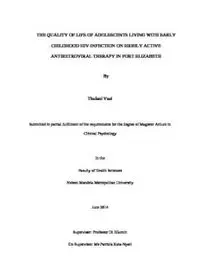
the quality of life of adolescents living with early childhood hiv-infection on highly active ... PDF
Preview the quality of life of adolescents living with early childhood hiv-infection on highly active ...
THE QUALITY OF LIFE OF ADOLESCENTS LIVING WITH EARLY CHILDHOOD HIV-INFECTION ON HIGHLY ACTIVE ANTIRETROVIRAL THERAPY IN PORT ELIZABETH By Thulani Vazi Submitted in partial fulfilment of the requirements for the degree of Magister Artium in Clinical Psychology In the Faculty of Health Sciences Nelson Mandela Metropolitan University June 2014 Supervisor: Professor Di Elkonin Co-Supervisor: Ms Patricia Kota-Nyati ii DECLARATION I, the undersigned, hereby declare that the research hereby submitted by me for the Magister Artium in Clinical Psychology at the Nelson Mandela Metropolitan University is my own work and that it has not previously been submitted for assessment or completion of any postgraduate qualification to another University or for another qualification. Thulani Vazi iii Acknowledgements I would like to extend my sincere gratitude to those who supported the successful completion of this piece of work. In particular, I’d like to thank: The Almighty, whose grace carries me, always. My mother and my siblings, whose love and support made the difficult times bearable. My supervisor, Di Elkonin, for helping me discover my researcher voice and believing in me even when I did not believe in myself. Inkosi ikusikelele. My co-supervisor, Phumeza Kota-Nyati, for your unwavering belief and support in this research project; and for playing the necessary varying roles at different times as you saw necessary. Thank you for always knowing. Nobulumko Cynthia Nomthandazo Busakwe, no words can capture your essence. You are love. My clinical supervisors, for lending their ears. The rest of my family and my dearest friends, for putting up with me. My fellow trainees, this has not been an easy road but here we are. Batho Ndoni, Chantal Goliath, Kanyisa Nyanga and Sihle Ntlangu for the technical assistance. The staff at Dora Nginza Hospital and Livingstone Hospital, especially Mr. Mpilo Fata, Mrs. Vunyelwa Ludwaba and Mrs. Barbara Berkatt. And most importantly, I’d like to thank the adolescents that participated in this study, without whom this research would not have been what it is. Salute! iv TABLE OF CONTENTS Declaration ii Acknowledgements iii Table of Contents iv List of Tables ix List of Figures x Summary xi Chapter 1: Introduction and Problem Statement 1 1.1 HIV infection in Children and Adolescents 2 1.1.1Transitions in Medical Care 3 1.2 Problem Statement 4 1.3 Primary Objectives of the Research 5 1.4 Chapter Overview of the Study 5 Chapter 2: The History of the HIV Pandemic and Chronic Illness 6 2.1 Introduction 6 2.2 The History of the HIV Pandemic 6 2.2.1 Global Statistics 8 2.2.2 Gender Dynamics in HIV 9 2.2.3 HIV and Poverty 10 v 2.2.4 Mother-to-Child HIV Transmission 10 2.2.5 Orphanhood due to HIV/AIDS 11 2.2.6 Antiretroviral Treatment in HIV Management 12 2.3 Chronic Illness 15 2.3.1 HIV Disease as a Chronic Illness 19 2.3.1.1 HIV-related Stigma 19 2.3.1.2 Impact of HAART on People Living With HIV/AIDS 20 2.4 Conclusion 22 Chapter 3: Adolescence and Quality of Life 23 3.1 Adolescence 23 3.1.1 Cognitive and Psychosocial Development 24 3.1.2 Pubertal Development 30 3.1.3 Adolescents with Chronic Illness 35 3.1.4 Adolescents living with HIV 38 3.1.4.1 HIV Status Disclosure 41 3.1.4.2 HAART Adherence 42 3.2 Quality of Life 43 3.2.1 Measuring Quality of Life 46 3.3 Conclusion 56 vi Chapter 4: Research Design and Methodology 58 4.1 Introduction 58 4.2 Research Aims 58 4.3 Research Methodology 58 4.3.1 Research Method 58 4.3.1.1 Research Design 59 4.3.2 Sampling and Participants 61 4.3.3 Data Collection 63 4.3.3.1 WHOQOL-HIV BREF 63 4.3.3.2 Individual Interviews 66 4.4 Research Procedure 67 4.5 Data Analysis 70 4.6 Ethical Considerations 73 4.7 Conclusion 75 Chapter 5: Results and Discussion 76 5.1 Introduction 76 5.2 Socio-demographic and Health Description of the Sample 76 5.2.1 Gender 76 5.2.2 Age Distribution 77 vii 5.2.3 Highest Educational Level 78 5.2.4 Marital Status 78 5.2.5 Ethnic Grouping 78 5.2.6 Health Status 79 5.2.7 Current Illness Status 80 5.2.8 Duration Aware of HIV Status 80 5.3 Quality of Life Results of the Sample 82 5.3.1 Mean Domain and Facet Scores 82 5.3.1.1 Domain Mean Scores 82 5.3.1.2 Facet Mean Scores 88 5.3.2 Quality of Life Across Gender 90 5.3.3 Quality of Life Across Age Group 93 5.4 Results from Individual Interviews 98 5.4.1 Thematic Analysis 101 5.5 Conclusion 109 Chapter 6: Conclusions, Limitations and Recommendations 110 6.1 Introduction 110 6.2 Conclusions Based on Results of the Study 110 6.3 Limitations of the Study 114 viii 6.4 Recommendations for Future Research 114 References 116 Appendices 180 Appendix A: Research Information Letter Appendix B: Consent Form Appendix C: Assent Form Appendix D: WHOQOL-HIV BREF (Original Version) Appendix E: WHOQOL-HIV BREF (Xhosa Translation) ix List of Tables Table 3.1 WHO Quality of Life Domains and Facets 52 Table 5.1 Gender Distribution of the Sample 77 Table 5.2 Age Distribution of the Sample 77 Table 5.3 Highest Education Level of Participants 78 Table 5.4 Ethnic Grouping of Participants 79 Table 5.5 Health Status Perception of Participants 79 Table 5.6 Current Illness Status Perception of Participants 80 Table 5.7 Duration Aware of HIV Status 81 Table 5.8 Domain Mean Scores of Participants 83 Table 5.9 Domain Mean Scores of Current Study and the PACTG Study 86 Table 5.10 Domain Mean Scores Across Gender 91 Table 5.11 Domain Mean Scores Across Age Group 94 x List of Figures Figure 2.1 HIV Infection 8 Figure 3.1 Marcia’s Adolescent Identity Statuses 26 Figure 5.1 Transformed Domain Mean Scores of Participants 84 Figure 5.2 Transformed Facet Mean Scores of Participants 88 Figure 5.3 Transformed Facet Scores (Adolescent Females) 92 Figure 5.4 Transformed Facet Scores (Adolescent Males) 92 Figure 5.5 Transformed Facet Scores (12 – 14 year olds) 95 Figure 5.6 Transformed Facet Scores (15 – 16 year olds) 96 Figure 5.7 Transformed Facet Scores (> 16 year olds) 96
